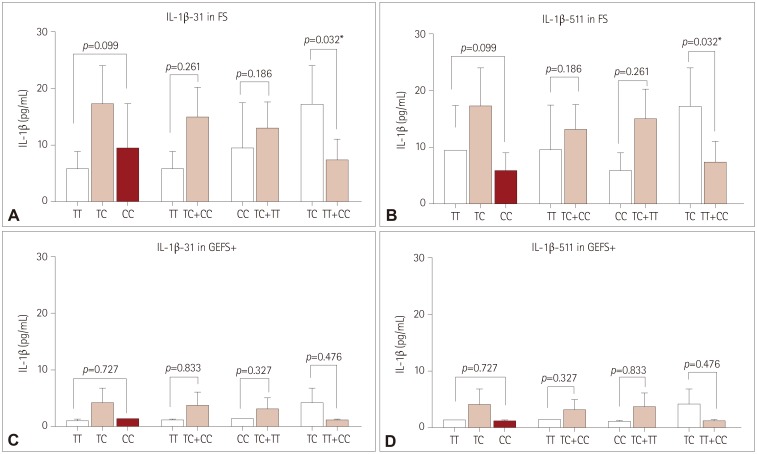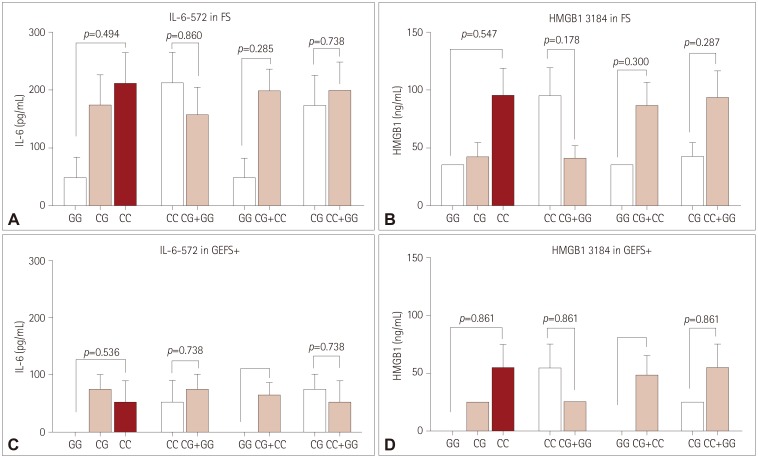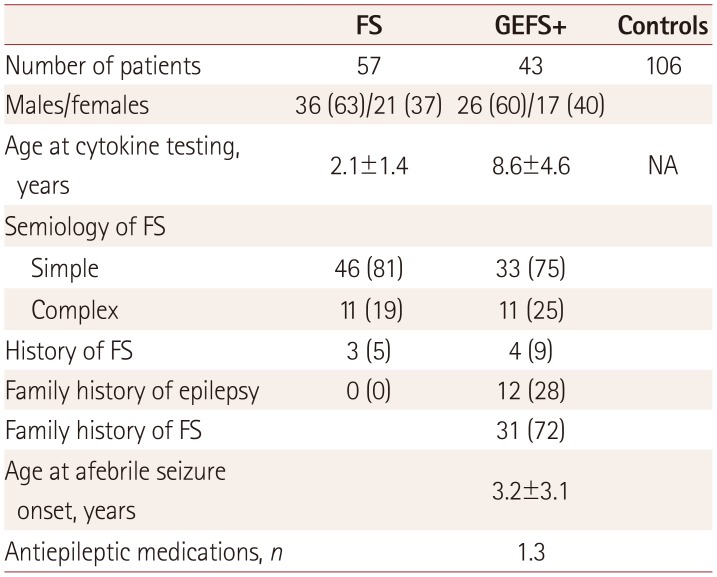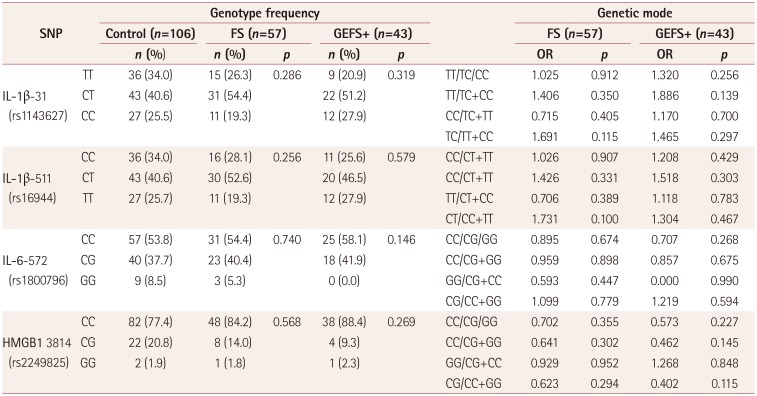1. Hauser WA. The prevalence and incidence of convulsive disorders in children. Epilepsia. 1994; 35 Suppl 2:S1–S6.

2. Millichap JG. Studies in febrile seizures. I. Height of body temperature as a measure of the febrile-seizure threshold. Pediatrics. 1959; 23:76–85. PMID:
13613867.
3. Scheffer IE, Berkovic SF. Generalized epilepsy with febrile seizures plus. A genetic disorder with heterogeneous clinical phenotypes. Brain. 1997; 120:479–490. PMID:
9126059.

4. Myers KA, Scheffer IE, Berkovic SF, Commission IG. ILAE Genetics Commission. Genetic literacy series: genetic epilepsy with febrile seizures plus. Epileptic Disord. 2018; 20:232–238. PMID:
30078767.

5. Zhang YH, Burgess R, Malone JP, Glubb GC, Helbig KL, Vadlamudi L, et al. Genetic epilepsy with febrile seizures plus: refining the spectrum. Neurology. 2017; 89:1210–1219. PMID:
28842445.
6. Choi J, Min HJ, Shin JS. Increased levels of HMGB1 and pro-inflammatory cytokines in children with febrile seizures. J Neuroinflammation. 2011; 8:135. PMID:
21989210.

7. Shi LM, Chen RJ, Zhang H, Jiang CM, Gong J. Cerebrospinal fluid neuron specific enolase, interleukin-1β and erythropoietin concentrations in children after seizures. Childs Nerv Syst. 2017; 33:805–811. PMID:
28236069.

8. Rana A, Musto AE. The role of inflammation in the development of epilepsy. J Neuroinflammation. 2018; 15:144. PMID:
29764485.

9. Virta M, Hurme M, Helminen M. Increased frequency of interleukin 1β (-511) allele 2 in febrile seizures. Pediatr Neurol. 2002; 26:192–195. PMID:
11955925.
10. Kanemoto K, Kawasaki J, Yuasa S, Kumaki T, Tomohiro O, Kaji R, et al. Increased frequency of Interleukin-1β-511T allele in patients with temporal lobe epilepsy, hippocampal sclerosis, and prolonged febrile convulsion. Epilepsia. 2003; 44:796–799. PMID:
12790892.

11. Yu X, Zhang N, Liu S, Xi Z, Zhang Y. Polymorphisms in the interleukin-1β (IL-1B) and interleukin-1α (IL-1A) genes on risk of febrile seizures: a meta-analysis. Neurol Sci. 2018; 39:1529–1536. PMID:
29808330.

12. Tilgen N, Pfeiffer H, Cobilanschi J, Rau B, Horvath S, Elger CE, et al. Association analysis between the human interleukin 1β (-511) gene polymorphism and susceptibility to febrile convulsions. Neurosci Lett. 2002; 334:68–70. PMID:
12431777.

13. Chou IC, Lin WD, Wang CH, Tsai CH, Li TC, Tsai FJ. Interleukin (IL)-1β, IL-1 receptor antagonist, IL-6, IL-8, IL-10, and tumor necrosis factor α gene polymorphisms in patients with febrile seizures. J Clin Lab Anal. 2010; 24:154–159. PMID:
20486195.

14. Capovilla G, Mastrangelo M, Romeo A, Vigevano F. Recommendations for the management of “febrile seizures”: Ad Hoc Task Force of LICE Guidelines Commission. Epilepsia. 2009; 50 Suppl 1:2–6.

15. Scheffer IE, Berkovic S, Capovilla G, Connolly MB, French J, Guilhoto L, et al. ILAE classification of the epilepsies: position paper of the ILAE Commission for Classification and Terminology. Epilepsia. 2017; 58:512–521. PMID:
28276062.
16. Yamada S, Inoue K, Yakabe K, Imaizumi H, Maruyama I. High mobility group protein 1 (HMGB1) quantified by ELISA with a monoclonal antibody that does not cross-react with HMGB2. Clin Chem. 2003; 49:1535–1537. PMID:
12928240.

17. Kwon JS, Joo YH, Nam HJ, Lim M, Cho EY, Jung MH, et al. Association of the glutamate transporter gene SLC1A1 with atypical antipsychotics-induced obsessive-compulsive symptoms. Arch Gen Psychiatry. 2009; 66:1233–1241. PMID:
19884611.

18. Xiong ZQ, Qian W, Suzuki K, McNamara JO. Formation of complement membrane attack complex in mammalian cerebral cortex evokes seizures and neurodegeneration. J Neurosci. 2003; 23:955–960. PMID:
12574424.

19. Viviani B, Bartesaghi S, Gardoni F, Vezzani A, Behrens MM, Bartfai T, et al. Interleukin-1β enhances NMDA receptor-mediated intracellular calcium increase through activation of the Src family of kinases. J Neurosci. 2003; 23:8692–8700. PMID:
14507968.

20. Roseti C, Van Vliet EA, Cifelli P, Ruffolo G, Baayen JC, Di Castro MA, et al. GABAA currents are decreased by IL-1β in epileptogenic tissue of patients with temporal lobe epilepsy: implications for ictogenesis. Neurobiol Dis. 2015; 82:311–320. PMID:
26168875.

21. Dubé C, Vezzani A, Behrens M, Bartfai T, Baram TZ. Interleukin-1β contributes to the generation of experimental febrile seizures. Ann Neurol. 2005; 57:152–155. PMID:
15622539.

22. Cho JH, Choi JS, Chun SW, Lee S, Han KJ, Kim HM. The IL-1B genetic polymorphism is associated with aspirin-induced Peptic Ulcers in a Korean Ethnic Group. Gut Liver. 2016; 10:362–368. PMID:
26601827.

23. Shahrokhi A, Zare-Shahabadi A, Soltani S, Ashrafi MR, Zoghi S, Hosseini SA, et al. Association of IL6 single nucleotide polymorphisms with febrile seizures. J Neurol Sci. 2014; 342:25–28. PMID:
24834995.

24. Nur BG, Sahinturk D, Coskun M, Duman O, Yavuzer U, Haspolat S. Single nucleotide polymorphism and production of IL-1β and IL-10 cytokines in febrile seizures. Neuropediatrics. 2012; 43:194–200. PMID:
22911481.

25. El-Omar EM, Carrington M, Chow WH, McColl KE, Bream JH, Young HA, et al. Interleukin-1 polymorphisms associated with increased risk of gastric cancer. Nature. 2000; 404:398–402. PMID:
10746728.

26. Al Morshedy S, Elsaadany HF, Ibrahim HE, Sherif AM, Farghaly MA, Allah MA, et al. Interleukin-1β and interleukin-1receptor antagonist polymorphisms in Egyptian children with febrile seizures: a case-control study. Medicine (Baltimore). 2017; 96:e6370. PMID:
28296777.
27. Diamond ML, Ritter AC, Failla MD, Boles JA, Conley YP, Kochanek PM, et al. IL-1β associations with posttraumatic epilepsy development: a genetics and biomarker cohort study. Epilepsia. 2014; 55:1109–1119. PMID:
24754437.

28. Hall SK, Perregaux DG, Gabel CA, Woodworth T, Durham LK, Huizinga TW, et al. Correlation of polymorphic variation in the promoter region of the interleukin-1β gene with secretion of interleukin-1β protein. Arthritis Rheum. 2004; 50:1976–1983. PMID:
15188375.

29. Maroso M, Balosso S, Ravizza T, Liu J, Aronica E, Iyer AM, et al. Tolllike receptor 4 and high-mobility group box-1 are involved in ictogenesis and can be targeted to reduce seizures. Nat Med. 2010; 16:413–419. PMID:
20348922.

30. Vezzani A, French J, Bartfai T, Baram TZ. The role of inflammation in epilepsy. Nat Rev Neurol. 2011; 7:31–40. PMID:
21135885.

31. Sha Y, Zmijewski J, Xu Z, Abraham E. HMGB1 develops enhanced proinflammatory activity by binding to cytokines. J Immunol. 2008; 180:2531–2537. PMID:
18250463.

32. Youn JH, Oh YJ, Kim ES, Choi JE, Shin JS. High mobility group box 1 protein binding to lipopolysaccharide facilitates transfer of lipopolysaccharide to CD14 and enhances lipopolysaccharide-mediated TNF-α production in human monocytes. J Immunol. 2008; 180:5067–5074. PMID:
18354232.

33. Chayka O, Kintscher J, Braas D, Klempnauer KH. v-Myb mediates cooperation of a cell-specific enhancer with the mim-1 promoter. Mol Cell Biol. 2005; 25:499–511. PMID:
15601869.
34. Bi D, Chen M, Zhang X, Wang H, Xia L, Shang Q, et al. The association between sex-related interleukin-6 gene polymorphisms and the risk for cerebral palsy. J Neuroinflammation. 2014; 11:100. PMID:
24903966.

35. Fornage M, Chiang YA, O'Meara ES, Psaty BM, Reiner AP, Siscovick DS, et al. Biomarkers of inflammation and MRI-defined small vessel disease of the brain: the Cardiovascular Health Study. Stroke. 2008; 39:1952–1959. PMID:
18436879.







 PDF
PDF ePub
ePub Citation
Citation Print
Print







 XML Download
XML Download